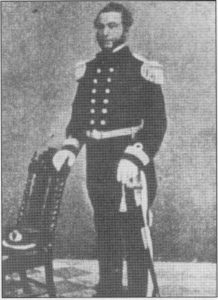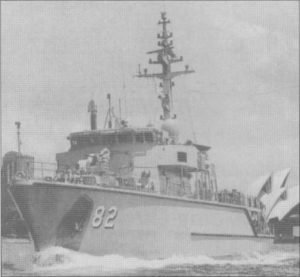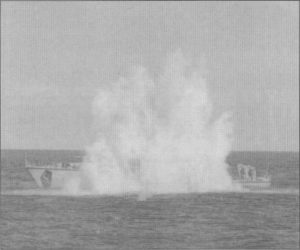- Author
- William F. Cook, MVO, Captain, RAN (Rtd)
- Subjects
- None noted
- Tags
-
- RAN Ships
- HMAS Waterhen, HMAS Huon II, HMAS Norman II
- Publication
- September 1999 edition of the Naval Historical Review (all rights reserved)

Courtesy Mitchell Library, Sydney
As the bottle of wine (Australian of course) shattered over her bows and Ms Agatha Grey-Wilson intoned the time hallowed words: “I name this ship Norman; may God bless her and all who sail in her”; the guests gave three cheers and the RAN band played appropriate music and Norman glided gracefully and so sedately in her launching cradle from terra firma where she was built to her natural element where she will spend the rest of her active life. Not for her the traditional stern first rush into the water with the clank and roar of restraining cables, tugs clutching the helpless ship to hold her and lead her to a wharf, or the less often used splash and roll of a broadside launch – a heart stopping sight! As she floated calmly from her cradle and was secured to the fitting out wharf, the guests were invited to the christening feast.
Monday, 3rd May 1999, was an auspicious day for many. For the Company – ADI Limited – it was the 10th anniversary of its establishment; for the Navy, Norman was the third of six River Class minehunters being built for the RAN and she was on schedule and within budget; for those survivors of the five `N’ class destroyers of WWII who were present it was a source of great pride to have a new ship named for one of their number – a ship to carry on the proud tradition of the 7th Destroyer Flotilla. All those people, including the 1700 Australian subcontractors (half of them based in the Hunter area) who are involved in her construction, no doubt also felt great satisfaction in the result of their work.
It was a perfect autumn day and most appropriate that the launching should be carried out by Ms Grey-Wilson, MBE. She is the great granddaughter of Captain William Henry Norman who was the first captain of the Victorian Sloop HMCS Victoria, a 580-ton armed steam screw sloop which cost £38,000 when launched in 1855.
After service in New Zealand during the Taranaki uprising in 1860, Captain Norman and his ship were sent to the north of Australia to search for, and hopefully rescue, members of the Burke & Wills expedition. Whilst in the Gulf of Carpentaria, the ship discovered and named the Norman River from which, being one of the River Class Minehunters, Norman derives its name. The details of his discovery are obscure, but Captain Norman was lucky. For in August 1841, when John Lort Stokes in HMS Beagle was making the initial survey of the eastern coast of the Gulf, he sent his assistant surveyor, Fitzmaurice, to carry out work ahead of the ship. Marsden Hordern (“Mariners are Warned” p.268) records: “Fitzmaurice had also noted another entrance six miles up the coast from Bynoe’s Entrance but, pressed for time, he had not entered it. Fortunately for Stokes’ peace of mind, he was not aware on hearing this that they had missed one of the gulf’s major rivers, the Norman, on which today stands the river port of Karumba and Normanton rail terminus”. (Stokes, of course, was hoping to find a large river rising near the centre of the continent and flowing into the Gulf which would open the inland to settlement.)

The first of this new class of minehunters, HMAS Huon, was handed over to the RAN on 25 March 1999 after a series of successful sea trials, “the major milestone in the whole process of preparing a warship for service”. Initially, these included trials of engine and generators and the minehunting sonar.

For the latter, a dummy minefield was laid off Newcastle and the sonar was required to detect the mines and then classify them. The minehunting auto pilot was also tested. This system enables a ship to follow a predetermined track through an area likely to be mined. The auto pilot steers the ship through the possible minefield and allows it to “hover” over programmed points. If the sonar makes a contact, one of the ship’s two mine disposal vehicles can be despatched to determine if it is a mine. Electrically powered, the vehicles are equipped with a mine disposal charge, searchlights, closed circuit television cameras, sonar, and are controlled via a fibre optic link. They can be deployed more than 500 metres from the ship. In August 1998 the integration and testing of the minehunters’ combat system was completed on shore in the ADI facility at Newcastle. It will be transferred in 1999 to HMAS Waterhen to be used as a training centre.




